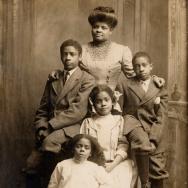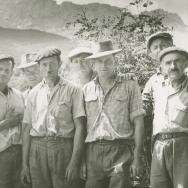The National Endowment for the Humanities has awarded the University of Chicago Library, in partnership with the Newberry Library and the Chicago History Museum, a grant to digitize historical maps of Chicago from the 19th century through 1940.
The grant of $348,930 to fund their proposal, “Mapping Chicagoland,” will also support the enrichment of the digital images with geographic information for use in spatial overlays and analyses, as well as the work to make them open to the public on the UChicago Library website. The maps will also be available through the BTAA (Big Ten Academic Alliance) Geoportal and Chicago Collections platforms.
The collaboration will draw on materials from all three institutions and leverage expertise and resources at the UChicago Library to scan, add spatial data, create metadata and make openly available 4,101 digitized maps in the fall of 2024. The maps range from the earliest cartographic representations of Chicago prior to its incorporation through its rapid expansion in the early 20th century. Maps from that period are rich sources of information for scholarly and community study that illuminate the history and contribute to our understanding of contemporary Chicago.
Leading the project is Cecilia Smith, director of digital scholarship at UChicago Library, in collaboration with James Akerman, director of the Newberry Library’s Smith Center for the History of Cartography, and Ellen Keith, director of research and access and chief librarian at the Chicago History Museum.
“The importance of these maps to our understanding of Chicago’s development is foundational,” said Smith. “Bringing our collections together in one openly accessible, digital place will have international impact for scholars and students. I’m thrilled by the Endowment’s support of our collaboration and I look forward to working with our partners to engage the Library’s deep digital expertise.”
Each institution’s collection of Chicago maps has unique strengths that complement one another in scale, time period, and subject.
The University of Chicago’s maps range from 1853-1940 and include maps produced by its Social Science Research Committee and map publishing companies, such as Rand McNally, transportation and utility companies and civic institutions. The maps cover social, urban and economic features such as land use, parks and urban planning.
Adrienne Brown, associate professor in the Department of English at UChicago, emphasizes the value of digitizing the collection for researchers: “Having thought a lot about how topography of Chicago has been illustrated, analyzed, and made anew through processes of mapping in my own research on the history of architecture, real estate, race and aesthetics, I can unequivocally say that having digital access to these materials will not only improve my future scholarship but will expand and deepen the work of countless scholars to come.”
The Newberry selected its extensive collection of large-scale real estate, fire insurance and land valuation atlases of parts of Chicago published from 1872-1924 for inclusion in this project. Among these are two atlases detailing the grounds of the World’s Columbian Exposition of 1893 and the Chicago Union Stockyards. The atlases show footprints of individual structures and lots, providing large scale details for studying Chicago’s cultural geography. “Collaborative digitization projects like ‘Mapping Chicagoland’ offer an ideal way of enhancing and multiplying access to our collection,” said Daniel Greene, president and librarian of the Newberry Library. “This project is an especially appropriate partnership because it taps into our great collecting strengths in historical cartography and Chicago history.”
The Chicago History Museum map collection includes maps of Chicago as early as 1812 and maps from Rufus Blanchard, one of the city’s first map publishers. Maps are categorized by topic, such as annexations and accretions, communities, parks, wards, industries, transportation, topography, cemeteries, world’s fairs and population. “We are excited to see how this project as a whole will expand the use of these primary sources and preserve a rich body of information on Chicago’s dynamic and complex urban development,” said Donald Lassere, president of the Chicago History Museum.
These early maps and atlases of Chicago are among the most popular collections within the three institutions, but only a small fraction of these maps is now available digitally. Providing open access to digitized and georeferenced map images will allow scholars worldwide to pursue broad research goals and incorporate primary and secondary cartographic sources in their teaching of Chicago’s pivotal transition into the 20th century.
"The University of Chicago Library is deeply involved in two organizations focused on documenting the history and culture of Chicago: the Black Metropolis Research Consortium (BMRC) and the Chicago Collections Consortium (CCC). Having such a rich geographical data source about the city will provide new dimensions to the kind of research that students and scholars can do with these consortial collections,” said Elisabeth Long, the Associate University Librarian for IT & Digital Scholarship at UChicago Library. “For example, the BMRC Summer Fellows program has hosted many scholars whose research looks at spatial aspects of Black history in Chicago—redlining, food deserts, health services and activism to name a few—which would benefit from having geo-referenced historical maps of the city. I am pleased that we can leverage the Library’s digital expertise to develop this important collaborative resource.”
The NEH grant is part of the Humanities Collections and Reference Resources (HCRR) program which advances scholarship, education, and public programming in the humanities by helping organizations steward important collections. Of the 206 eligible HCRR applicants received by the Endowment this round, 36 proposals were selected. In the funding announcement, the NEH chair Shelly C. Lowe said that the “projects will expand the horizons of our knowledge of culture and history, lift up humanities organizations working to preserve and tell the stories of local and global communities, and bring high-quality public programs and educational resources directly to the American public.”
—A version of this story was first published by the UChicago Library.












 —Prof. Chuan He
—Prof. Chuan He
